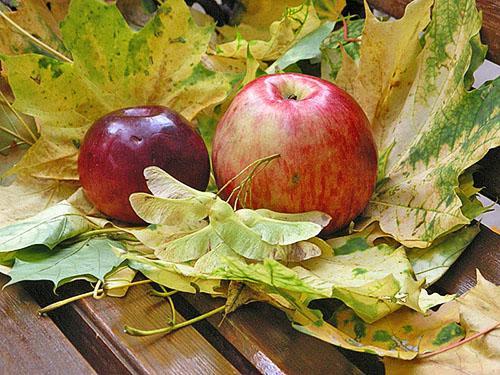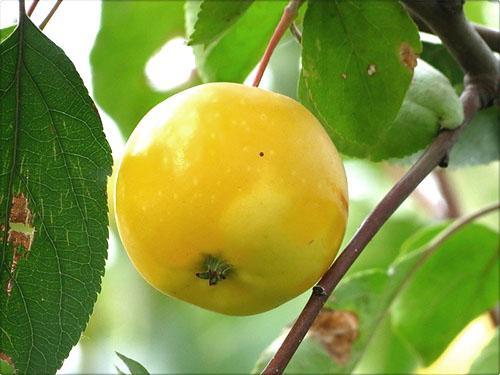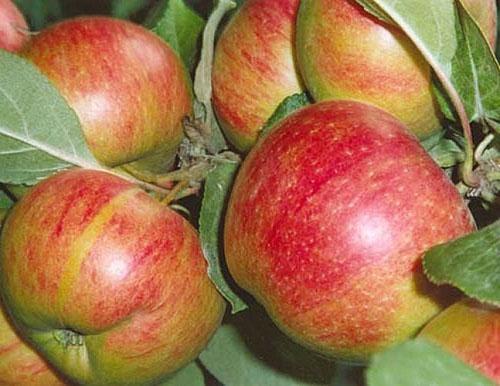Description and photos of autumn varieties of trees in the apple orchard
 When choosing varieties of fruit trees for an apple orchard, they invariably pay attention to how soon the apple tree enters the fruiting season, the taste and size of the fruits, the resistance of the variety to frost and lack of moisture, diseases and pests. Thanks to the efforts of breeders, gardeners can choose between tall and dwarf trees. However, no less important is the ripening period of the harvest on apple trees, since only taking this criterion into account can a garden be established that can provide a person with vitamin fruits from mid-summer until next spring.
When choosing varieties of fruit trees for an apple orchard, they invariably pay attention to how soon the apple tree enters the fruiting season, the taste and size of the fruits, the resistance of the variety to frost and lack of moisture, diseases and pests. Thanks to the efforts of breeders, gardeners can choose between tall and dwarf trees. However, no less important is the ripening period of the harvest on apple trees, since only taking this criterion into account can a garden be established that can provide a person with vitamin fruits from mid-summer until next spring.
At the same time, autumn varieties of trees in an apple orchard should account for about a third of all plantings. Aromatic strong apples, ripening in September, go not only to the table, when consumer maturity occurs in 12-15 days, but are also perfectly stored until mid-winter.
Description of the apple-tree variety Uralskoe bulk

And due to the high rate of adaptation, early maturity and winter hardiness, they are in demand today in most areas with harsh climatic conditions. Already from the second year of life, the cultivated plant gives the first apples, and in the third year the productivity approaches full. The maximum yield obtained from the Ural bulk apple tree is up to 250 kg.
The apples of this variety have a yellowish juicy pulp, which becomes much looser when overripe, a sweet taste with subtle acidity and a pronounced aroma. Fruit ripening begins closer to mid-September, while ripe apples do not crumble, and after picking up to 2 months retain their quality and taste.
According to the description, small rounded fruits of the Ural bulk apple tree do not exceed 60 grams. Apples have an elongated stalk, like a ranetka, a smooth shiny skin and first a yellow-green, and then an even yellow color, on which, when exposed to the sun, a slight, barely noticeable pink blush forms.
Apple Cinnamon new
 A well-known variety of late autumn ripening was developed on the basis of VNIIS im. I.V. Michurin, the famous breeder S.I. Isaev. The apple tree variety Cinnamon striped and variety Welsey were chosen as the starting material for hybridization.
A well-known variety of late autumn ripening was developed on the basis of VNIIS im. I.V. Michurin, the famous breeder S.I. Isaev. The apple tree variety Cinnamon striped and variety Welsey were chosen as the starting material for hybridization.
The variety, which entered the State trials in 1950, was zoned for cultivation in the Central and North-West regions of the country after 15 years. In the non-chernozem zone of Russia, apple orchards, established from vigorous, strong trees of this variety, are actively used today. The variety is high-yielding, has good resistance to scab, and shows average winter hardiness in the center of Russia.
The crown of a young Cinnamon new apple tree has a shape close to pyramidal, but as it grows, it expands and becomes rounded. Most of the ovary is formed on annelids, and only a small part is formed on elongated flexible fruit rods. Apple trees begin to bear fruit relatively late, only at 6–7 years of age, while in mature trees the years of abundant harvests alternate with periods of rest.
The Cinnamon nova apple tree is characterized by large, dark green ovoid leaves with pointed elongated tips, noticeable pile and jagged edges. When the plant blooms in the second half of May, the tree is covered with large white-pink flowers, in the place of which fruits are subsequently formed, weighing from 20 to 180 grams. Rounded-conical or slightly flattened apples of this variety are covered with a thick, smooth skin of a greenish-yellow color with a speckled or blurred striped blush of a red-carmine shade.
The fruits of Cinnamon New are distinguished by the highest commercial qualities, they are juicy with a sour-sweet taste and are in no way inferior to most southern varieties. The apples, taken in early September, fully reveal their taste after 3 - 4 weeks, and in a cool room they can be stored until winter.
Apple-tree Uralets
 A vigorous frost-resistant apple tree of the Uralets variety is the result of the work of P.A. Dibrova. At the Sverdlovsk OSS, in the middle of the last century, the scientist crossed a pink-striped Anis with a Chinese woman Voskovka and a Saratov Ukrainian woman.
A vigorous frost-resistant apple tree of the Uralets variety is the result of the work of P.A. Dibrova. At the Sverdlovsk OSS, in the middle of the last century, the scientist crossed a pink-striped Anis with a Chinese woman Voskovka and a Saratov Ukrainian woman.
The variety obtained by the scientist with a pyramidal strong crown that withstands up to 70 kg of fruits in productive years has become in demand in many northern regions of Russia and in the middle lane. Even under heavy load, branches covered with medium-sized leaves do not break off. The blossoming of apple trees in the Urals falls in May. The buds are pink and the blossoming flowers are white. Self-pollination of this variety does not occur, so the owner of the apple orchard can plant the trees of the Ural Bulk as a pollinator.
The ovary develops on shoots for 2–3 years. Small rounded-conical fruits become ripe from the first half of autumn. The average weight of a sweet and sour aromatic apple of this variety does not exceed 50-60 grams. At the same time, the surface color of the fruits, sitting heap on elongated peduncles, is creamy, with a thick striped blush. The waxy coating is clearly visible on the skin.
Fruiting of the Uralets apple variety begins at the age of 4–6 and takes place annually, and the harvest only grows from year to year, regardless of weather conditions.
Apple tree Auxis
 Thanks to the crossing of the Grafenstein red and Macintosh varieties, Lithuanian breeders have obtained the Auxis apple variety with a compact rounded crown of medium thickening and fruits of autumn ripening.
Thanks to the crossing of the Grafenstein red and Macintosh varieties, Lithuanian breeders have obtained the Auxis apple variety with a compact rounded crown of medium thickening and fruits of autumn ripening.
The flowering of trees of this autumn variety in the apple orchard begins towards the end of May, while the presence of other varieties of apple trees nearby is necessary for pollination of flowers. As a result, medium-sized fruits are formed, whose weight ranges from 90 to 180 grams. Apples with an oily, smooth skin have an even, flattened-rounded shape and a greenish-yellow color at the stage of removable ripeness, on which a rich carmine or red blush, covering almost the entire surface of the fruit, stands out. Sweet and sour refreshing apples, ripening in mid-September, have dense yellow flesh, which does not lose its structure during storage until the end of winter.
The first fruiting of the Auxis apple tree more often occurs 4–5 years after planting. At the same time, the variety in the middle zone shows average winter hardiness and the same resistance to scab. In addition, the fruits not harvested on time fall off.
Apple tree Anis Sverdlovsky
 The apple variety Anis Sverdlovsky, which yields a harvest in late autumn, is the fruit of the work of the breeders of the Sverdlovsk experimental gardening station, under the leadership of L.A. Kotova. The plant was grown by crossing Melba and Anis purple, while the crown of the apple tree is closer to an oval or wide pyramid in shape. The tree is medium-sized with a mixed type of fruiting. Although on the densely strewn branches of two-year-old ringlets, most of the pink flowers are formed, and then the ovary.
The apple variety Anis Sverdlovsky, which yields a harvest in late autumn, is the fruit of the work of the breeders of the Sverdlovsk experimental gardening station, under the leadership of L.A. Kotova. The plant was grown by crossing Melba and Anis purple, while the crown of the apple tree is closer to an oval or wide pyramid in shape. The tree is medium-sized with a mixed type of fruiting. Although on the densely strewn branches of two-year-old ringlets, most of the pink flowers are formed, and then the ovary.
The regular round or oval fruits of the Anis Sverdlovsky apple tree have an average weight of 100 to 120 grams.Apples have dry, smooth, medium-thick skin with a light yellow integumentary color, which is sometimes almost invisible under a deep red blurred blush. On ripe fruits, a wax bloom of a bluish hue is clearly visible.
Apples have juicy, fine-grained flesh of white or sometimes greenish tint. The taste of ripe fruits taken from the apple tree of Anis Sverdlovsky in early September is sweet and sour, deserving high expert assessments. However, this autumn variety cannot be called maturing. The maximum storage period is December. The tree gives the first ovary already in the fourth year after grafting, tolerates winter well and even after frost damage to individual shoots it quickly recovers, but in rainy seasons it is often affected by scab.
Description and photo of the autumn striped apple tree
 The variety of the old folk selection came to central Russia from the Baltic states, therefore the Autumn striped apple trees are called Streyfling or Strefil. There are other variants of the name. The apple trees reach a height of 8 meters, while the rounded dense crown of the tree has a diameter of up to 7 meters. The shoots are covered with large oval leaves with a noticeable silvery pile and jagged edges. Branches can sag to the ground under the weight of a ripening crop.
The variety of the old folk selection came to central Russia from the Baltic states, therefore the Autumn striped apple trees are called Streyfling or Strefil. There are other variants of the name. The apple trees reach a height of 8 meters, while the rounded dense crown of the tree has a diameter of up to 7 meters. The shoots are covered with large oval leaves with a noticeable silvery pile and jagged edges. Branches can sag to the ground under the weight of a ripening crop.
According to the description and photo of the Autumn striped apple tree, these trees are little affected scab and hardy enough. At the same time, the annual growth on trees is small, and the first fruits are tied only in the fifth or sixth year. The yield is also slowly increasing. But upon reaching the age of 25-30, an apple tree of this variety, which receives the proper amount of moisture and nutrients, is capable of producing up to 300 kg of fruit.
After pollination of the buds, the ovary actively grows, the fruits are colored only in August, and ripen in mid-September. The shape of large yellow-green apples with dashed blush is irregularly rounded, sometimes conical, with ribs noticeable closer to the upper part. The pulp is white firm, with a pleasant refreshing taste.
Apple trees varieties Zhigulevskoe
 The high-yielding variety obtained in 1936 at the Samara experimental station has long established itself as unpretentious and high-yielding. Apple trees of the Zhigulevskoe variety are the result of crossing Borovinka and the prize Wagner variety. The variety turned out to be quite winter-hardy and quickly recovering after severe frosts.
The high-yielding variety obtained in 1936 at the Samara experimental station has long established itself as unpretentious and high-yielding. Apple trees of the Zhigulevskoe variety are the result of crossing Borovinka and the prize Wagner variety. The variety turned out to be quite winter-hardy and quickly recovering after severe frosts.
Relatively low, but giving good growth, trees of this autumn variety in the apple orchard can be distinguished by the thinned wide pyramidal crown, the first apples on which appear five years after planting. At the same time, the plants bear fruit annually, giving rounded fruits, juicy with a crane blush, weighing from 130 to 200 grams. Apples are stored until the second half of winter.
Apple-tree Bessemyanka Michurinskaya
 A vigorous variety obtained by IV Michurin as a result of crossing between Bessemyanka Komsinskaya and the Skrizhapel variety, has a powerful spreading crown and begins to bear fruit from 5 to 7 years after planting. The average yield of an apple orchard planted from trees of the Bessemyanka Michurinskaya variety is 130 kg per plant.
A vigorous variety obtained by IV Michurin as a result of crossing between Bessemyanka Komsinskaya and the Skrizhapel variety, has a powerful spreading crown and begins to bear fruit from 5 to 7 years after planting. The average yield of an apple orchard planted from trees of the Bessemyanka Michurinskaya variety is 130 kg per plant.
Flowering begins in the second half of May, and the fruits ripening in September weigh 110–130 grams and are distinguished by excellent taste. The apple of the Bessemyanka Michurinskaya variety has a light yellow integumentary color and a blush of merging orange and red stripes throughout the skin of the fruit that retains its freshness until December. Apple trees winter well in the middle zone and are rarely affected by scab. The only drawback of the variety is the uneven ripening of crumbling apples.